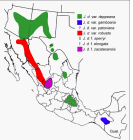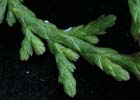
Tree (var. deppeana) in habitat, Sedona, AZ [C.J. Earle, 1987.12.27].

Distribution of the varieties of J. deppeana. Adapted from Adams and Schwarzbach (2006).

Stand of J. deppeana var. deppeana in southern Puebla [C.J. Earle, 2005.02.10].

Bark on the tree shown above, about 50 cm dbh [C.J. Earle, 2005.02.10].

Sectioned cone collected in Durango [C.J. Earle, 2007.02.10].

Detail of twig and foliage of var. deppeana [C.J. Earle, 2007.02.10].

Detail of berries, twig and foliage of var. deppeana [C.J. Earle, 2007.02.10].

Trees of var. robusta at km 154 on the Durango-Mazatlan highway [C.J. Earle, 2007.02.10].

Detail of twig and foliage of var. robusta collected near the J. blancoi type locality south of El Salto, Durango [C.J. Earle, 2007.02.10].

Conservation Status

Juniperus deppeana
Steudel (1840)
Common names
Alligator juniper (Elmore and Janish 1976), mountain, thickbark, oak-barked, or checker-barked cedar (Peattie 1950), cedro, cedro chino [in Puebla], sabino, táscate [in Chihuahua and Durango], tláscal or tláxcal [in Hidalgo], huata, agoriza [in Sonora], aborí, aorí, awarí, aworíki, kawarí, koarí, petcalawa, waaka [Tarahumar people of Chihuahua], ga'a [Pima people of Chihuahua] (Zanoni and Adams 1979).
Taxonomic notes
Four varieties according to Adams and Schwarzbach (2006), who base their analysis on DNA sequencing data using nrDNA and trnC-trnD sequences:
- Var. deppeana (includes formae elongata, sperryi and zacatecensis)
- Var. gamboana
- Var. patoniana
- Var. robusta
The remainder of this page describes the species, with a key to the varieties; see the links above for detail on varieties deppeana and gamboana.
Description
"Trees dioecious, to 10-15(-30) m, single-stemmed; crown rounded. Bark brown, exfoliating in rectangular plates (rarely in thin strips in f. sperryi, but then branchlets flaccid), that of small branchlets (5-10 mm diam.) smooth, that of larger branchlets exfoliating in plates. Branches spreading to ascending; branchlets erect, rarely flaccid, 3-4-sided in cross section, ca. 2/3 or less as wide as length of scalelike leaves. Leaves green, but sometimes appearing silvery when glaucous, abaxial gland ovate to elliptic, conspicuous, exudate absent, margins denticulate (at 20´); whip leaves 3-6 mm, not glaucous adaxially; scalelike leaves 1-2 mm, not overlapping, keeled, apex acute to mucronate, appressed. Seed cones maturing in 2 years, of 2 distinct sizes, with straight to curved peduncle, globose, 8-15 mm, reddish tan to dark reddish brown, glaucous, fibrous to obscurely woody, with 1-7 seeds. Seeds 6-9 mm" (Adams 1993, Adams and Schwarzbach 2006). See García Esteban et al. (2004) for a detailed characterization of the wood anatomy.
Adams and Schwarzbach (2006) provide the following key to the varieties and formae of J. deppeana:
1a. |
Terminal whips long (15 - 30 cm) and pendulous, all (or nearly all) leaves on adult plants juvenile (decurrent, or whip type) |
var. deppeana f. elongata |
1b. |
Terminal whips short (5 - 10 cm) and not pendulous, all leaves on adult plants scale-like (except on new growth where whip leaves occur) |
2 |
2a. |
Seed cones small (5-8 mm diam.), with soft pulp and 1(2) seeds, reddish brown with a light bloom, Chiapas, Mexico and adjacent Guatemala |
var. gamboana |
2b. |
Seed cones large (8-20 mm diam.), woody and (1) 2 - 7 seeds, brown, reddish brown, or purplish with little to copious bloom, from central Mexico northward to Arizona and New Mexico in USA. |
3 |
3a. |
Stem bark longitudinally furrowed into long, interconnected strips, terminal whip branches often flaccid and pendulous |
var. deppeana f. sperryi |
3b. |
Stem bark in quadrangular plates or in longitudinal strips (occasionally interconnected, if exfoliating in strips, then foliage not weeping), occasionally quadrangular plates at the trunk base, terminal whip branches ascending to erect |
4 |
4a. |
Stem bark exfoliating in longitudinal strips (occasionally interconnected) or with plates near the trunk base |
var. patoniana |
4b. |
Stem bark exfoliating in square or oblong quadrangular plates, not in strips. |
5 |
5a. |
Trees with a strong central axis, no major side branches, crown pyramidal, and open as in Hesperocyparis, often with 2 (3-4) trunks rising at (or below) ground level |
var. robusta |
5b. |
Trees with round crown, branching at 1-4 m to produce irregular, round crown, usually with a single trunk |
6 |
6a. |
Mature female cones larger, 10-20 mm. diam., heavy bloom (glaucous waxy coating) on cone surface causes cone to appear white; shrub/small round topped tree (to 8m) |
var. deppeana f. zacatecensis |
6b. |
Mature female cones smaller, 8-15 mm diam., glaucous or not, if glaucous not appearing as white, small to large trees |
var. deppeana |
Distribution and Ecology
USA: Arizona, New Mexico, Texas; Mexico: Aguascalientes, Chiapas, Chihuahua, Coahuila, Durango, Hidalgo, Jalisco, México, Michoacán, Nuevo León, Puebla, San Luis Potosí, Sonora, Tamaulipas, Tlaxcala, Veracruz, and Zacatecas; Guatemala; at 1500-2900 m (Zanoni and Adams 1979, Adams 1993). Hardy to Zone 8 (cold hardiness limit between -12.1°C and -6.7°C) (Bannister and Neuner 2001). See also Thompson et al. 1999.
Map of the the distribution of Juniperus deppeana, with undifferentiated J. deppeana shown in red, var. deppeana in orange, var. gamboana in green, var. patoniana in yellow, var. robusta in lavender, and var. zacatecensis in blue. Map based on GBIF Occurrence Download https://doi.org/10.15468/dl.d23zc3 and GBIF Occurrence Download https://doi.org/10.15468/dl.6fdugj, both retrieved 2023.08.06; data limited to occurrences with coordinate uncertainty <10 km and trimmed to eliminate extralimital occurrences, likely misidentifications, and location duplicates within a nearest-neighbor distance of 1 km. See figure at right for approximate distribution of other varieties.
The conservation status of this species is variable. Farjon (2013, accessed 2022.03.20), reporting a 2011 conservation assessment, provides a "Least Concern" ranking for the type variety and var. pachyphlaea (which is here treated as synonymous with var. deppeana). Var. robusta is ranked "Vulnerable". Var. zacatecensis is "Endangered" and var. sperryi "Critically Endangered" (note that both vars. are here reduced to formae of the type variety, per the findings of Adams and Schwarzbach (2006)). Farjon does not recognize var. patoniana, treating it as synonymous with var. robusta. He elevates var. gamboana to species rank, designating it "Endangered."
Remarkable Specimens
The largest reported tree is in var. deppeana.
Ethnobotany
Observations
I found numerous fine examples of var. robusta west of El Salto along the Durango-Mazatlan highway in Durango. See also the links to varieties deppeana and gamboana.
Remarks
The epithet honors Ferdinand Deppe (1794-1861), a German naturalist, explorer and painter, who collected plants in Mexico with Scheide in 1828-29.
Citations
Adams, Robert P. 1993. Juniperus. Flora of North America Editorial Committee (eds.): Flora of North America North of Mexico, Vol. 2. Oxford University Press. This document is available online. Go to http://www.efloras.org, click on "Flora of North America," and search for "Juniperus."
Adams, Robert P. and Andrea E. Schwarzbach. 2006. Infraspecific adjustments in Juniperus deppeana (Cupressaceae). Phytologia 88(3):227-232.
Steudel, E. G. von. 1840. Nomenclator botanicus enumerans ordine alphabetico nomina atque synonyma... Ed. 2, V. 1. Stuttgart: Tubingen (p. 835).
See also
R.P. Adams' web site, juniperus.org.
Elwes and Henry 1906-1913 at the Biodiversity Heritage Library (as J. pachyphlaea). This series of volumes, privately printed, provides some of the most engaging descriptions of conifers ever published. Although they only treat species cultivated in the U.K. and Ireland, and the taxonomy is a bit dated, still these accounts are thorough, treating such topics as species description, range, varieties, exceptionally old or tall specimens, remarkable trees, and cultivation. Despite being over a century old, they are generally accurate, and are illustrated with some remarkable photographs and lithographs.
Farjon (2005) provides a detailed account, with illustrations.
Little (1980).
Threatened Conifers of the World (addresses several infraspecific taxa).









